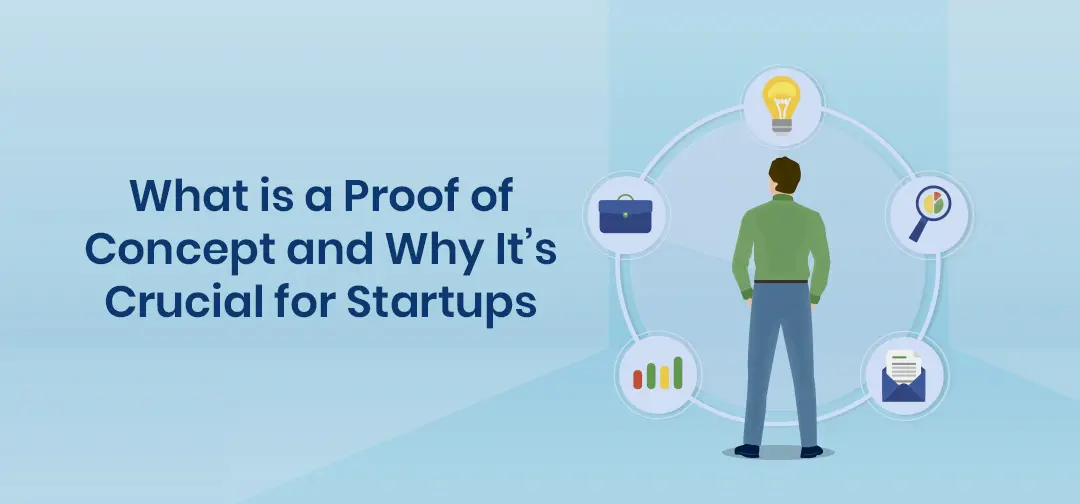The startup environment is fast-paced, so having a great idea marks the starting point for success. The main difficulty emerges from demonstrating that the PoC concept possesses practicality alongside market feasibility. Research indicates that a shortage of market demand leads to startup failure in 42% of cases, thus demonstrating why early validation matters. A Proof of Concept (PoC) serves as a critical step in this validation process. This blog explores what a PoC is, what a Proof of Concept stage entails, how it differs from other validation methods like prototypes and MVPs, why it’s crucial for startups, and how it can attract investors.
What is a Proof of Concept (PoC)?
A Proof of Concept (PoC) is a small-scale validation method that demonstrates the feasibility of an idea, technology, or business model. A proof of concept for startup companies allows them to evaluate technical feasibility, which prevents wasting resources on incomplete full-scale projects.
Key Benefits of a PoC
- The technical feasibility evaluation determines if the planned technology execution is possible.
- Risk Reduction occurs by detecting significant obstacles which developers need to address before starting extensive work.
- Investor and Partner Attraction demonstrates potential to stakeholders and venture capitalists.
- The optimization of resources becomes possible through this approach to help organizations distribute funds and talent effectively.
- Market Validation confirms that the idea solves a real problem in the market.
PoC vs. Prototype vs. Minimum Viable Product (MVP)
Many startups confuse PoCs, prototypes, and MVPs, but they serve distinct purposes at different stages of product development:
| Feature | Proof of Concept (PoC) | Prototype | Minimum Viable Product (MVP) |
| Purpose | Tests feasibility of an idea in a controlled setting | Preliminary working model showcasing design, functionality, or user experience | Functional product with minimal features released to early adopters to test market demand |
| Audience | Internal team and stakeholders | Test users or designers | Early adopters and customers |
| Development Stage | Early-stage validation | Mid-stage concept development | Late-stage product testing before scaling |
| Outcome | Confirms whether the idea is viable | Demonstrates functionality and gathers feedback | Provides real-world user validation before scaling |
At Navyug Global, we emphasize the importance of PoCs in reducing risks and refining product development strategies before committing to full-scale development.
Why is PoC Crucial for Startups?
Reducing Risk and Avoiding Costly Mistakes
Startups must validate their ideas before spending product development resources because they have limited funding available. A failed PoC is far less costly than a failed product launch.
Strengthening Investor Confidence
Investors and venture capital firms prefer backing ideas that have undergone feasibility testing. A successful PoC concept signals that the startup has minimized risks and has a realistic roadmap for execution.
Accelerating Time-to-Market
By identifying and addressing challenges early, a PoC helps streamline the product development process, enabling startups to launch a refined product faster.
Enhancing Product Development Strategy
A PoC provides valuable insights that help refine the business model, technology stack, and feature set, ensuring that startups build a product that meets market demands.
Steps to Develop a PoC
Step 1: Define the Core Concept
Your concept needs to describe the problem it addresses together with the compelling reasons to pursue this solution. The development process requires identification of essential assumptions which need to be verified.
Step 2: Set Success Criteria
Define what a successful PoC looks like. The success criteria for a Proof of Concept can take technical form such as error-free software execution or market orientation through potential customer interest.
Step 3: Develop a Basic Working Model
Develop an abbreviated test model which exclusively shows that your concept is possible before advancing forward.
Step 4: Gather Feedback and Analyze Results
Test the PoC with internal teams, industry experts, or a small group of target users to validate assumptions and identify areas for improvement.
Step 5: Decide Next Steps
Based on the findings, determine whether to proceed to a prototype, make refinements, or pivot the idea entirely.
Real-World Examples of PoC Success
Dropbox – Using an Explainer Video as a PoC
Dropbox avoided the creation of a complete product by releasing a short video that showed how their system would operate. The strong market response proved the existence of demand which led to early-stage funding acquisition.
Airbnb – Testing Demand by Renting Out Their Own Apartment
The founders of Airbnb began their experiment by adding their personal apartment to the short-term rental listings. The successful trial demonstrated market interest which resulted in the complete development of the platform.
Navyug Global – Driving Innovation with PoCs
At Navyug Global, we use PoCs across diverse industries—including technology solutions and infrastructure—to validate ideas before scaling them into full-fledged businesses.
Common Pitfalls to Avoid in PoC Development
- Lack of Clear Objectives – Without a well-defined hypothesis, a PoC can fail to deliver actionable insights.
- Overcomplicating the PoC – A PoC should be simple and focus only on proving feasibility.
- Ignoring Market Feedback – Failing to incorporate user feedback can lead to incorrect assumptions.
- Underestimating Time and Costs – Even a small-scale PoC requires planning to avoid unnecessary delays and expenses.
The Role of PoC in Venture Capital Funding
Investors seek startups that have demonstrated feasibility and market potential. A strong PoC can:
- Validate the business model and reduce perceived risks.
- Serve as a proof point during funding pitches.
- Attract early-stage investors looking for innovative solutions.
How to Use a PoC for Fundraising
- Showcase a Working Model – Investors prefer tangible evidence over theoretical concepts.
- Highlight Success Metrics – Use PoC results to demonstrate viability.
- Leverage PoC Learnings to Strengthen Business Strategy – Investors value founders who iterate based on validated insights.
The Bottom Line
A Proof of Concept is an essential step in transforming an idea into a successful startup. By testing feasibility early, startups can minimize risks, attract venture capital, and refine their product development strategy.
At Navyug Global, we actively support startups that leverage PoC concepts for innovation. Whether you are developing a new technology, infrastructure project, or consumer product, validating your idea through a PoC can significantly increase the chances of success.




